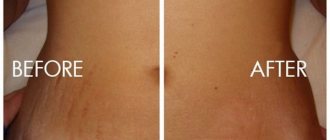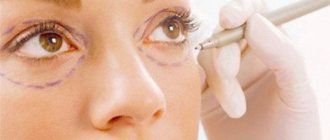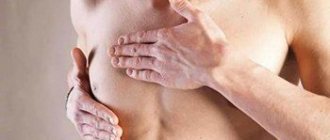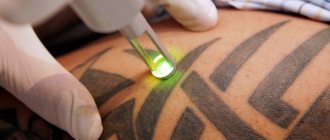Surgery for diastasis of the rectus abdominis muscles—the divergence of tendon fibers in the area of the so-called “white” line—is often the only way to eliminate the defect. If at first patients are only concerned about the cosmetic effect - a protrusion in the form of a roller, which appears during tension, then over time - as the disease progresses - it is possible that breathing, digestion, and blood circulation may be impaired, hernias appear, displacement of the abdominal organs, which leads to limited ability to work.
There is no single correction method; treatment tactics are selected individually for each patient. If at the initial stage the distended shape of the abdomen can still be corrected with the help of specially selected exercises, then in advanced cases the exercises will not bring the desired result. Then the violation can be corrected only with the help of an operation, the purpose of which is to eliminate diastasis and strengthen this section of the peritoneal wall. But in any case, the disease will not disappear on its own.
The surgical technique for diastasis of the rectus abdominis muscles is selected depending on the stage of the disease, the presence/absence of ptosis (drooping) of the skin, scars on the anterior abdominal wall, as well as the wishes of the patient herself.
Our clinic uses a set of proprietary minimally invasive techniques at different stages of the disease.
- At stage I, transumbilical plastic surgery using a mesh endoprosthesis is indicated (recommended for a diastasis length of 4-6 cm) or laparoscopy of abdominal muscle diastasis, which uses a mesh intra-abdominal endoprosthesis (for a defect of 6-18 cm).
- At stages II-III, laparoscopic plastic surgery is recommended, in which a mesh endoprosthesis is used or not, suturing is performed with a long-term absorbable thread.
In the presence of ptosis or unaesthetic scars, plastic surgery using an endoprosthesis is combined with abdominoplasty. The combination of adequately selected access and type of operation allows us to achieve excellent results. Moreover, if there is a concomitant ventral hernia or pathologies of the abdominal organs, we always eliminate them.
Find out the cost by phone: +7 (495) 782-50-10
Duration 60-120 minutes
Time in hospital 2-3 days
The peculiarity of my approach to performing diastasis correction using minimally invasive techniques
There is no single way to correct abdominal diastasis, just as there are no similar women. In each specific case, everything is decided individually, based on the stage of the disease, associated cosmetic problems and the wishes of the patient.
The choice of surgical intervention method for diastasis depends on the stage of the disease, the presence or absence of ptosis (drooping) of the skin and unsightly scars on the anterior abdominal wall.
I perform a whole range of proprietary minimally invasive procedures
interventions at various stages of the disease:
Stage 1 – transumbilical plastic surgery of diastasis using a mesh endoprosthesis (with a diastasis length of 4-6 cm) or laparoscopic plastic surgery of diastasis using a mesh intraperitoneal endoprosthesis (with a diastasis length of 6-18 cm);
Stages 2 and 3 – laparoscopic diastasis repair using thread suturing with a long resorption period using or without a mesh intraperitoneal endoprosthesis;
Stages 1,2,3, in the presence of abdominal ptosis or unsightly scars on the anterior abdominal wall - abdominoplasty in combination with diastasis plastic surgery and the use of a mesh endoprosthesis.
At any stage of the disease and the presence of concomitant ventral hernias, their simultaneous correction is always performed.
If there are concomitant diseases of the abdominal and pelvic organs (gastrointestinal tract disease, ovarian cyst, etc.), if the patient wishes, these problems can also be eliminated using laparoscopic access.
All operations can be divided according to the type of access to the midline and the type of reconstruction of the abdominal wall itself. A reasonable combination of access and type of intervention gives an excellent result of the operation.
All operations are performed under general anesthesia.
Rice. 1. Transumbilical plastic surgery of diastasis with mesh endoprosthesis
Rice. 2. Classical open plastic surgery of diastasis with local tissues without a mesh implant (incision 12-14 cm).
Rice. 3. Option of laparoscopic diastasis repair using a mesh intraperitoneal endoprosthesis
Rice. 4. Option of laparoscopic diastasis repair using a mesh intraperitoneal endoprosthesis
Rice. 5. Abdominoplasty in combination with diastasis plastic surgery and the use of a mesh endoprosthesis.
Patent. Method of Lipoabdominoplasty with navel relocation
Stretching of the linea alba during pregnancy
Stretching of the vertical abdominal muscles during pregnancy is associated with the characteristics of your body. As the fetus grows, it takes up more and more space in the woman's uterus. She pushes the organs apart, and the vertical abdominal muscles also move apart.
After childbirth, the body recovers over time, but it also happens that the sprain does not disappear. What remains is a flabby belly, which does not decorate a woman.
Diastasis can appear even 4 months after birth if the white tendon plate in the abdominal area has decreased its ability to contract. If after pregnancy a young mother begins to load her body too early or intensively, this can also provoke pathology.
An effective way to avoid the development of diastasis after childbirth is sports. It is advisable to regularly devote time to physical activity several months before pregnancy so that the muscular system is properly strengthened. While waiting for the baby, it is also recommended to do exercises regularly, if your health allows.
Some doctors also recommend wearing a bandage during pregnancy as a preventative measure. It cannot be guaranteed that it will definitely help to avoid pathology, but it will significantly relieve the burden. The main thing is to select and wear it as prescribed by your doctor.
Transumbilical plastic surgery of diastasis with mesh endoprosthesis
I use this type of operation for stage 1 diastasis.
The essence of the technique is as follows. On the skin of the abdomen, around the navel, I make a cosmetic incision - a mini access of 3-4 cm. Next, under endoscopic control, I separate the aponeurosis along the edge of the diastasis at a distance of 10-16 cm (depending on the size of the defect). Then I open the sheath of the rectus muscles on both sides and place a mesh implant in their bed (Fig. 1). I fix the endoprosthesis around the perimeter with a non-absorbable thread “Prolene 2-0” on an atraumatic needle. Thus, the implant is located in the bed of the rectus abdominis muscles, and the abdominal organs are protected by the wall of the rectus sheath and the peritoneum. In front, above the mesh, there is a layer of muscle, aponeurosis, subcutaneous tissue and skin. Therefore, patients do not feel the implant; after germination with its own connective tissue, it becomes a second native aponeurosis. At the next stage, I perform suturing of the aponeurosis and elimination of diastasis (the rectus abdominis muscles come closer together - this leads to their good function and cosmetic effect). The wound must be closed with an intradermal cosmetic suture. For comparison, the view of the abdominal wall is shown when a classic open diastasis is performed with local plastic tissue (Fig. 2) without a mesh implant (incision 12-14 cm).
Diastasis in men and women
According to statistics, abdominal diastasis occurs in two out of 200 people. It occurs in men, but it is mainly a female disease, which is especially common after childbirth and cesarean section. In addition, doctors identify the following reasons for the divergence of the vertical abdominal muscles:
- increased physical activity;
- hereditary increased extensibility of ligaments;
- rapid and intense weight loss;
- obesity.
People who often suffer from constipation and a hacking cough are also at risk.
Regardless of the origin, the problem should be addressed as soon as possible. The patient needs to consult a doctor and remove the diastasis. It is advisable not to delay solving the problem, otherwise an abdominal hernia may develop.
Abdominoplasty in combination with diastasis plastic surgery and the use of a mesh endoprosthesis.
I use this type of operation for all stages of the disease, in the presence of abdominal ptosis or unsightly scars on the anterior abdominal wall.
The essence of the technique is as follows. Depending on the severity of soft tissue ptosis and the thickness of the subcutaneous fat layer of the abdominal wall, the presence of rough and unsightly scars on the anterior abdominal wall, one or another type of abdominoplasty is performed. During abdominoplasty, the sheath of the rectus muscles is opened on both sides and a mesh implant is placed in their bed, which is fixed around the perimeter with a non-absorbable thread “Prolene 2-0” on an atraumatic needle (Fig. 5). Next, the aponeurosis is sutured and the diastasis is eliminated. At the same time, the rectus abdominis muscles come closer together, which leads to their good function and cosmetic effect. At the final stage, the wound after abdominoplasty is closed and the subcutaneous tissue is drained.
Causes of the disease
Among women
The main reason for women is pregnancy. The increasing size of the uterus puts pressure on the “white line”, stretching the connective tissue, which gradually becomes thinner. The number of pregnancies, the density of connective tissue and its ability to stretch play an important role. With age, the strength of the “white line” decreases, therefore, the older the age at which pregnancy occurs, the higher the risk.
In children
In newborns, this is considered normal because the muscles are not yet strong enough. Even a full stomach can easily move the rectus muscles apart. Gradually, tissues and muscles become stronger, and the pathology goes away. This process is delayed in premature and weakened children. With Down syndrome, diastasis can remain for life.
In men
The main reasons are high body weight and heavy lifting. It is important to strengthen the abdomen in childhood, otherwise after 30 years, as tissue elasticity is lost, diastasis may develop.
Combination of diastasis with hernias
It should be borne in mind that diastasis is not a hernia. Due to the absence of a hernial orifice, through which abdominal organs can fall out and become pinched, there is no threat to human health. However, the combination of diastasis with hernias (umbilical, linea alba) is quite common. During stage III expansion, they are constant companions. In addition, when a hernia recurs, diastasis often acts as an unfavorable factor. Therefore, during surgery for a hernia, correction of diastasis is necessary.
At any stage of the disease and the presence of concomitant ventral hernias
– their simultaneous correction is always performed.
If there are concomitant diseases of the abdominal and pelvic organs (gastrointestinal tract disease, ovarian cyst, etc.), if the patient wishes, these problems can also be eliminated using laparoscopic access. At the same time, cholecystectomy, removal of fibroids, ovarian cysts, endometriosis, etc. can be performed.
Rehabilitation
The rehabilitation period is relatively easy. At first there is swelling, hematomas, and pain. The first ones gradually go away on their own, and the pain is relieved with a drug prescribed by the doctor.
In the first month, you should not lift anything heavier than 3 kg. For two months you should not overheat, go to the sauna, sauna, or take a hot bath. The body must be protected from the sun; you cannot sunbathe or swim in the pool. Sports are also banned for two months.
The bandage is worn for 2-3 months.
Diastasis is a serious problem that women most often face after pregnancy. It is impossible to connect the separated muscles of the “white line” either with diets or exercises. SM-Clinic surgeons come to the rescue, restoring beauty and self-confidence.
Yakimov Dmitry Konstantinovich
Doctor of the highest category. Candidate of Medical Sciences. Member of the Society of Plastic Surgeons. Author of more than 30 works in the field of surgery, teacher at the Military Medical Academy.
Postoperative period
Surgical treatment of diastasis of the rectus abdominis muscles using tension plasty without a mesh implant implies a longer recovery. The patient is prohibited from lifting weights (more than 10 kg), as well as from playing sports for the first three months. In addition, the patient is considered disabled for a long time.
After minimally invasive surgery, the person operated on can get out of bed on the first day. Immediately after the intervention, a special bandage is put on, which should be worn for 1.5 months. 2 days after the operation, the patient can leave the clinic on her own. After 14 days, you can begin to gradually return to normal life. 2 months after surgery, a person can begin to play sports.
To obtain the best cosmetic effect, it is not recommended to expose the suture area to ultraviolet irradiation (tanning) for a year. After 6 months you can become pregnant and give birth.
Doctor's comment
The birth of a child, physical activity, weight gain or sudden changes in weight have led to the fact that the stomach began to look unsightly, and physical exercise does not produce tangible results? Correction of a stretched abdominal line with the help of training is effective only at the initial stage of the disease. In an advanced state, as well as a year after the birth of a child, it is possible to get rid of the defect and strengthen the abdominal wall only with the help of surgical treatment. It is necessary to take into account that diastasis will not disappear on its own, and the disease will certainly progress. At the initial stage, correction is possible with the help of special exercises, but they must be selected by a specialist. If the only effective solution is surgical, then in our Center surgery for diastasis of the rectus abdominis muscles can be performed in several ways; the technique is selected for each individual strictly individually. Don’t wait for such developments, make an appointment and together we will discuss all the advantages of possible methods!
Head of the surgical service at SwissClinic Konstantin Viktorovich Puchkov
results
After suturing diastasis, you get not only a healthy body, without pathologies, but also an aesthetic figure:
- skin stretch marks are removed;
- fat is removed;
- Abdominal flabbiness is eliminated;
- the shape and location of the navel changes;
- a pronounced waist is formed;
- a beautiful muscle relief is created.
Advanced suturing techniques reduce recovery time. After healing, barely noticeable scars and scratches remain on the body, which are hidden even by the smallest swimsuit.
Possible consequences
Usually, for abdominoplasty with diastasis, people turn to doctors complaining of an unattractive figure, but this pathology is dangerous to a greater extent not because of the violation of aesthetics, but because of the negative consequences for health. In advanced forms, it can cause unpleasant complications:
- pain in the back and abdomen, especially during exercise;
- disruptions in the functioning of the digestive, respiratory and circulatory systems;
- increased risk of hernia formation;
- prolapse of internal organs.
No matter whether you are worried about an unattractive figure or painful symptoms, it is advisable to consult a doctor. You can order an examination at our surgical clinic in Novorossiysk, and a specialist will recommend treatment tactics. We offer the full range of services necessary to completely eliminate the pathology.










